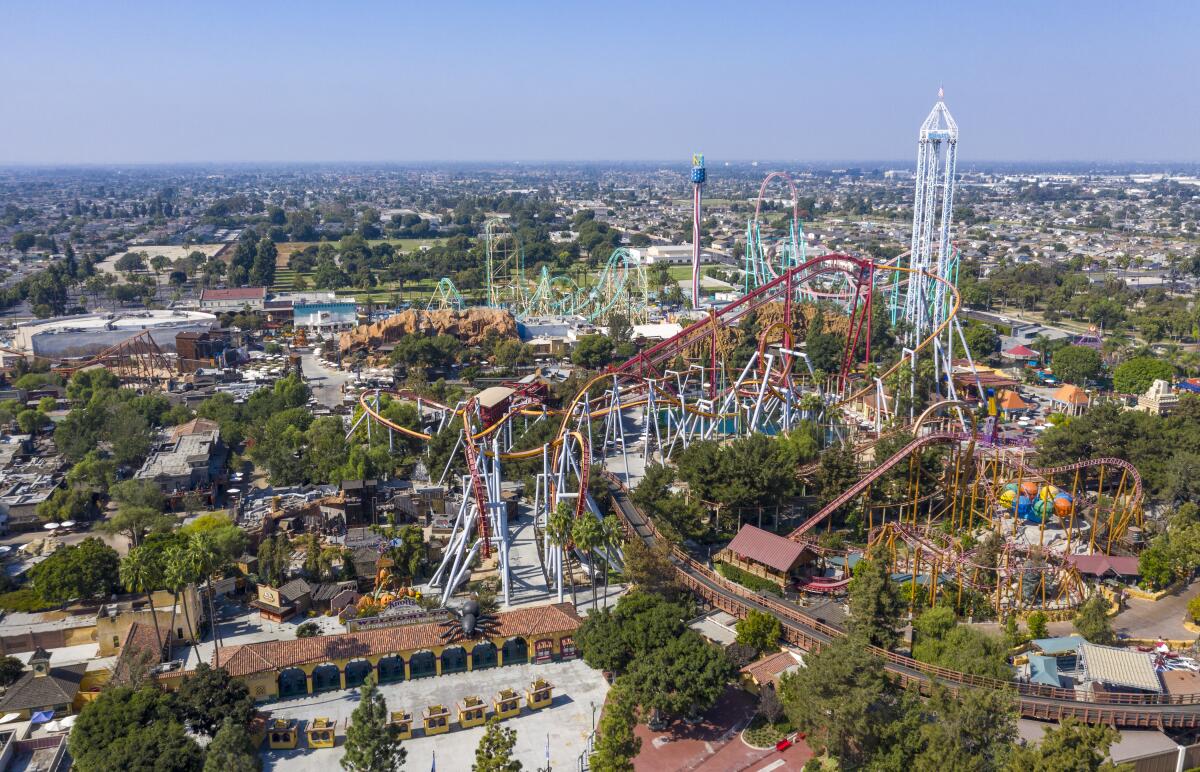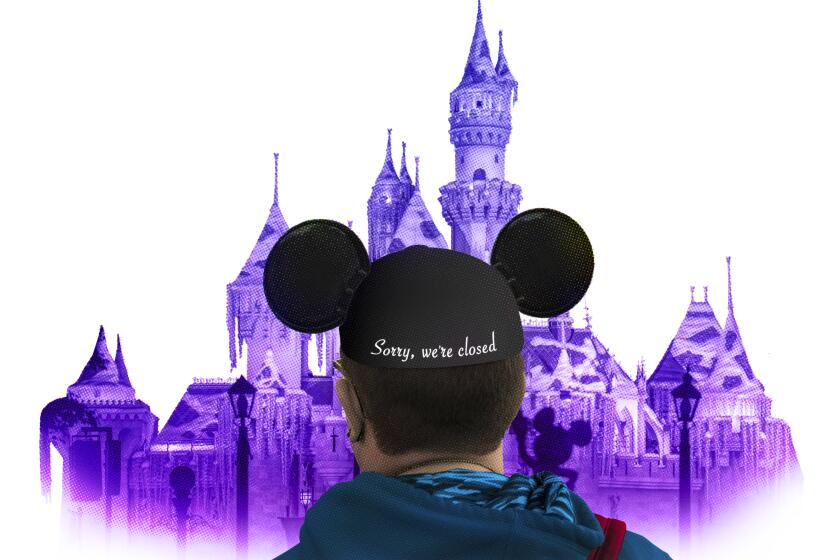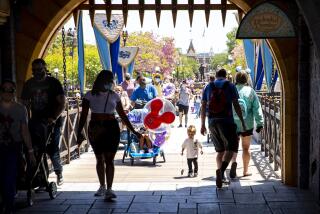New rules keep Disneyland and many other California theme parks closed for now

Facing increased pressure from business owners and politicians in places with theme parks, California released protocols for operating the parks, giving destinations such as Disneyland, Universal Studios and Knott’s Berry Farm a path to reopening that is tied to how well each park’s home county throttles the spread of the coronavirus.
It might be many months before major parks are allowed to welcome guests again. Based on an Orange County official’s projections, Disneyland probably won’t open before summer — news that incensed park executives and local officials.
“There is a path forward. We don’t know when, but we know how” the parks will reopen, said Dr. Mark Ghaly, the state’s secretary of Health and Human Services.
The protocols announced Tuesday require large parks to wait longer than smaller ones. A large park, defined as one with a capacity of more than 15,000 visitors, can reopen once coronavirus transmission in its home county has fallen enough for the county to reach Tier 4 — the state’s least-restrictive designation. A small park, meanwhile, can welcome guests once its home county reaches Tier 3, the second-least-restrictive level.
The loss of thrills, laughter and magic. Can Disneyland fanatics carry on without the “Happiest Place on Earth”?
Ghaly laid out some other restrictions as well: All parks must sell tickets in advance to make contact tracing easier, and face coverings will be mandatory except when eating or drinking.
Large theme parks will be limited to 25% capacity.
Small theme parks will be limited to 25% capacity or 500 visitors, whichever is fewer; can accept only visitors who live in the county; and can operate only outdoor attractions.
Asked whether the protocols would force some theme parks to remain closed for months, Ghaly pointed to San Francisco, which has seen success in lowering virus transmission and recently moved into the least restrictive tier.
For other counties, throttling the spread of the coronavirus enough to match that performance “will require a lot of work. It will require a lot of vigilance,” he said. “We believe it’s possible.”
As COVID-19 rages in Florida and California, what does it mean that Disney World is open while Disneyland remains closed even for its 65th birthday?
Theme park executives and the mayor of Anaheim immediately excoriated the guidelines, complaining that the new protocols would keep the parks closed too long and hurt nearby businesses.
“These state guidelines will keep us shuttered for the foreseeable future, forcing thousands more people out of work, leading to the inevitable closure of small family-owned businesses, and irreparably devastating the Anaheim/Southern California community,” Disneyland Resort President Ken Potrock said in a statement.
Anaheim Mayor Harry Sidhu said he believed Disneyland should be able to open under Tier 3, along with smaller parks. “This fails the working families and small businesses of Anaheim,” he said of the new protocols.
Under Gov. Gavin Newsom’s Blueprint for a Safer Economy opening plan, each county is assigned to one of four tiers based on the number of coronavirus cases per 100,000 residents and the rate of positive tests it has, as well as an equity benchmark. The lower the case numbers and positive test rate, the fewer restrictions are imposed on schools and businesses.
A county must remain in a tier for at least three weeks before moving to a less-restrictive tier.
Los Angeles County, home of Universal Studios Hollywood and Six Flags Magic Mountain, is in Tier 1, the most restrictive. Orange County — home of Disneyland, Disney California Adventure Park and Knott’s Berry Farm — and San Diego County, home of Legoland and SeaWorld, are in Tier 2.
Orange County is not likely to reach Tier 4 until summer 2021 or perhaps later, Dr. Clayton Chau, director of the Orange County Health Care Agency, said during an Orange County Board of Supervisors meeting Tuesday.
Universal Studios Hollywood and Legoland executives joined Tuesday’s outcry, saying their parks should not have to wait for Tier 4. “Our employees are ready to go back to work, and the fact that they won’t be able to do so until well into next year is shameful,” Karen Irwin, president of Universal Studios Hollywood, said in a statement.
Dr. Robert Kim-Farley, an epidemiologist and infectious diseases expert at the UCLA Fielding School of Public Health, called the state’s approach to reopening theme parks “prudent and reasonable.”
“Theme parks are potential areas of transmission,” he said. “I don’t think we want to trade off opening up a theme park if it means that our children are not going to be able to go back to in-person classrooms because the increase in transmission could occur.”
California’s announcement comes four months after theme parks in Florida, including the four parks in Walt Disney World there, were allowed to reopen with capacity limits, mask and temperature-check requirements and the elimination of events that draw people to crowd together such as parades and fireworks shows. The Disneyland parks in Paris, Shanghai and Hong Kong Disneyland have all reopened as well.
The question of when and how to reopen California’s amusement parks has been fraught. The parks began in September to publicly pressure Newsom to provide a path to reopening. Local business interests and politicians joined the chorus. Walt Disney Co.’s executive chairman, Bob Iger, resigned from Newsom’s economic task force — an abrupt public confirmation of the growing tensions.
A coalition of unions representing workers at the Disneyland Resort issued a statement Monday asking the governor to include them in the reopening discussions. The unions said they had reached agreements with Disneyland management on safety protocols, although those guidelines were not released.
The state’s theme parks voluntarily shut down in March after California recommended canceling all gatherings of more than 250 people amid the growing COVID-19 pandemic.
The closures have dealt an economic blow to the state, especially to cities in Southern California.
Researchers at Cal State Fullerton estimate that the Disneyland Resort alone normally contributes $8.5 billion a year to Southern California’s economy and, before the pandemic, employed about 31,000 workers, representing 3.6% of all jobs in Orange County.
In Anaheim, the September unemployment rate was still above 11%, and Sidhu has said the city faces a projected $100-million deficit partly due to the loss of hotel taxes paid by overnight visitors.
Although theme parks have reopened in Florida and other states, the pandemic has resulted in $23 billion in economic losses for theme parks across the country in 2020, according to the International Assn. of Amusement Parks and Attractions, a trade group with members in more than 100 countries.
The pressure on Newsom to release guidelines to reopen the theme parks began to build last month, with Disney officials and the mayors of Anaheim and two adjacent cities speaking out about the financial effects of the closures and noting that Disney’s Florida parks reopened in July.
Newsom was set to announce the protocols Oct. 2, but the California Attractions and Parks Assn. balked after seeing a draft. It asked him to delay and work with the parks in what the association’s executive director called a “more earnest manner, listening to park operators’ expertise and collaborating with the industry.”
Newsom has since sent a team of people to theme parks open in other states to learn what precautions those parks have taken to deter the spread of the coronavirus. He did not appear Tuesday at the event announcing the state’s new theme park protocols; instead, Ghaly delivered the news.
In the spring, Disney furloughed more than 100,000 workers from its theme parks, cruise lines and movie studio division and continued to provide those workers with healthcare benefits. But, facing continued financial pressure, on Sept. 29 the Burbank company announced plans to lay off 28,000 employees at its parks, experiences and products division, which includes Disneyland Resort and Disney California Adventure Park in Anaheim and Walt Disney World in Orlando, Fla.
The cuts affect employees across the U.S., but Disney executives put part of the blame for their decision on California’s “unwillingness to lift restrictions that would allow Disneyland to reopen.”
Universal Studios Hollywood declined to say how many workers it had furloughed, but the Hollywood Reporter reported that the park had furloughed at least 849 employees and permanently cut 1,374 staffers in Los Angeles County since July 1. The park has noted that the company continues to pay for the healthcare benefits of all furloughed workers.
Southern California’s theme parks have made efforts to keep revenue flowing during the closures, with Universal Studios Hollywood and the Disneyland Resort reopening their adjacent shopping and dining districts this summer.
Knott’s Berry Farm launched an outdoor dining and retail effort, called Taste of Knott’s, where visitors can eat, drink and buy souvenirs in sections of the park on weekends.
Disney, Universal Studios and Knott’s have imposed health and safety protocols for the reopened shopping and dining areas, including temperature screening of all guests before entering, plus mask and physical distancing requirements.
Times staff writer Rong-Gong Lin II contributed to this report.








